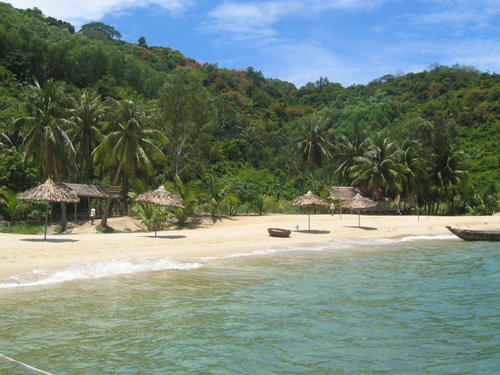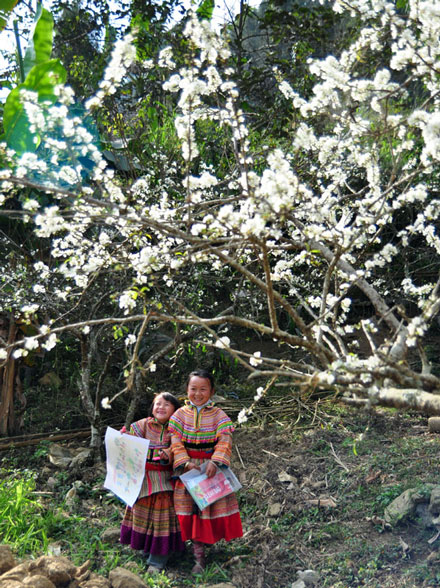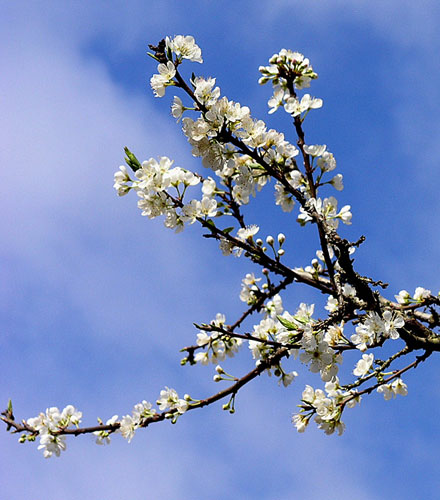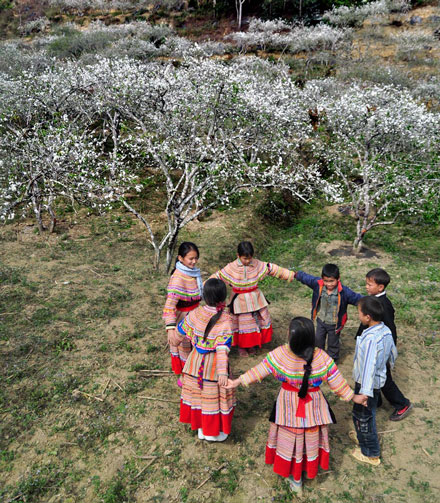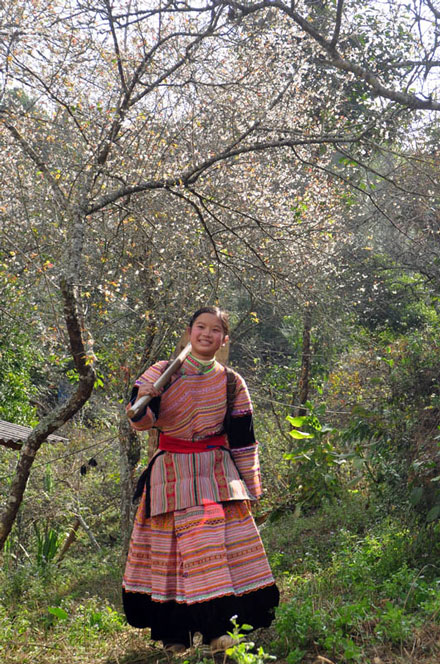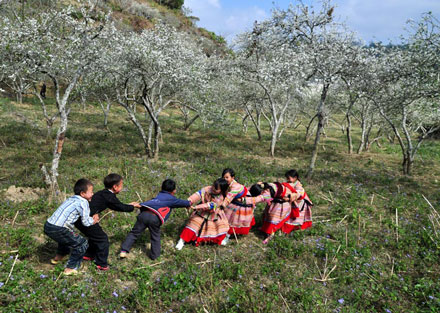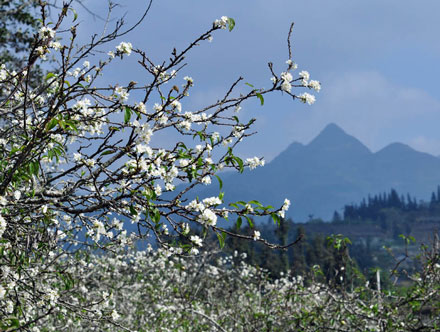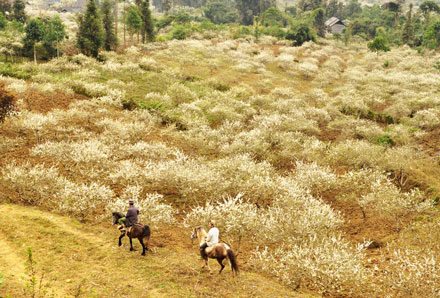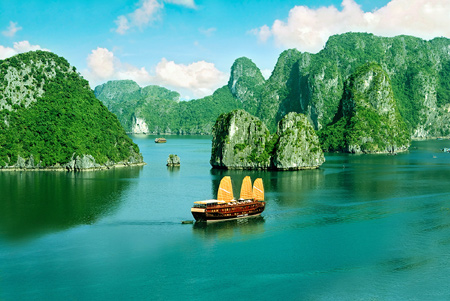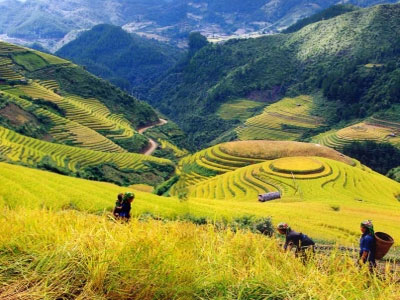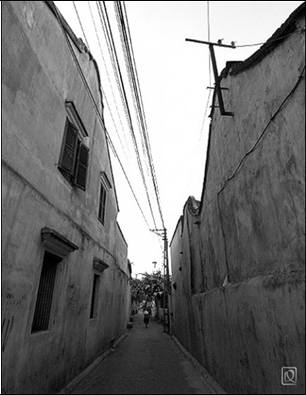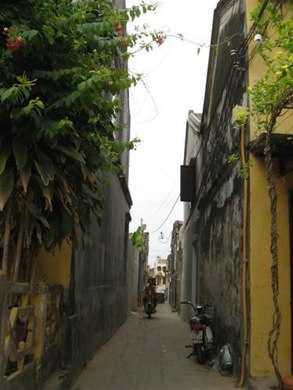In colonial days, the mountains surrounding Sapa were known as the Tonkinese Alp for the quasi-European climate, with the town functioning as a former hill station, built by the French as a retreat from the heat for vacationing military officers. It is also home to Vietnam’s highest peak, Mount Fansipan, which towers above the town at a height of 3,143 metres.
Terraced fields, Sapa, Vietnam
Planning a cycling trip in these remote areas of Vietnam as a solo traveller might not be the wisest decision, primarily due to the need for special permits in the less well-discovered areas, but I knew I could do without, having lived for nearly 8 years in Vietnam.
I decided to initiate my 18 year-old son, Sacha, to the art of cycling his first bicycle trip ever. Our first challenge was to put the bikes on the train from Hanoi to Lao Cai and then bike 40 kilometres uphill to Sapa. There are many trains from Hanoi to Lao Cai. However, almost all sleeper seats are controlled by travel agents. It is impossible to buy sleeper tickets. Some seat tickets or a few second class sleepers may be available at the train station without pre-booking. Ask the travel agents for the departure. Our first day: on reaching the Lao Cai train station, at about 6am, you have two choices: bike the 35km uphill if you are up to it or take the minibus.
The country has 54 ethnic groups, giving Vietnam the richest and most complex ethnic makeup of Southeast Asia. The majority of the ethnic minorities live in the hilly regions of the Northwest, with other tribes scattered in the Central Highlands and the South. However, the Northwest is the best place to start, as traditional dress in the central and southern parts has been displaced by a more casual approach.
Sapa speaks the language of tourism and is no longer a secret but one can not escape its exquisite views. It is also home to Vietnam’s highest peak, Mount Fansipan, which towers above the town at a height of 3,143 metres.
The Black H’mong and the Red Dao are two of the main tribes in this area. The Dao shave their eyebrows and the hair around their faces to highlight their beauty and are very distinctive with their cherry head coverings, jingling with silver coins. The Black H’mong, in contrast, knots their long dark hair inside tall headdresses, and wears indigo-dyed clothes that shimmer in the light. Dressed in their traditional finery, these tribal women cheerfully intermingle on the streets of Sapa, often inspecting each others’ handwork, while packing sleeping babies on their backs in beautifully embroidered cloth carriers.
Our second day: Ban Ho village, located more than 26 kilometres away from the famous resort town of Sapa and home to the Tay minorities. Situated alongside a turquoise fast growing stream, you must take the time to explore this village before pushing on over the suspension bridge and trekking through rice fields to the Red Dao village of Nam Toong.
Even though Ban Ho is not too far from the centre of Sapa, not many tourists have visited the village because of the tough approach road, which is under construction and slippery in the rainy season.
However, the village is also accessible by riding from Sapa. I recommend staying with my old friend Mr. Son, the chief of the village and his wife, Ms. Lu Thi Ut. The best homestay in the village for the night with a traditional Tay dinner and breakfast.
Our third day: we covered the 26 kilometres and went back to Sapa in the morning, and biked the 15 kilometres from Sapa to the remote Ta Phin village which still retains the traditional customs and lifestyle of ethnic minority groups. Set within a valley with a touring peaking mountain at one end, this village is alive with the daily life of the Kinh, Red Dao and Black H’mong people.
The valley floor is layered with rice paddies and dotted with 20 small home communes. Above them are some smaller communes and a patchwork of corn and vegetable fields. When heading off to Ta Phin village from Sapa, biking up and down the 15 kilometres of hilly terrain is a good choice as travellers will see local people working in terraced paddy fields, or travelling back and forth from the market to their homes. And after a long day of biking on the windy roads and hills you can soak your bones and muscles in a traditional Red Dao herbal bath in one of the homestays. All around the village there is an energy generated by the daily life of the locals here.
The Red Dao, distinguished by their impressive headdress, and the Black H’mong, in their shiny indigo-dyed clothes have lived here for almost 400 hundred years.
Our fourth day: early rising from Ta Phin village and continue winding our way through the scenic hills and valleys from Sapa to the new Lai Chau town. Passing the Silver Waterfall, we cycle up to Tram Ton pass at 2,000m above sea level. Our most challenging day with 115 kilometres to the new administrative town of Lai Chau.
Our fifth day: a very picturesque, easy riding and mostly downhill 40 kilometres to a beautiful hotel made of bamboo and rattan where we settled on the edge of a national park. The vegetation in the valleys is out of this world.
Our sixth day: 75 kilometres to the old Lai Chau, a small town nestled in the heart of a beautiful valley carved from spectacular mountains by the Da River. The town, no more than half a mile in length, initially had little to offer, but the area itself is a biking goldmine. The weather can be pretty hot here, so you need plenty of water for biking, but the views as you rise up through the valley are well worth it. In June and July temperatures can rise as high as 40 degrees centigrade making this the hottest place in Vietnam; the rise in temperature is related to the southeast summer monsoon blasting in from the Indian Ocean with the surrounding mountains enclosing the heat.
Our seventh day: 100 kilometres to Dien Bien Phu. The city lies in Muong Thanh Valley and is surrounded by sleep, heavily forested hills and mountains. This valley witnessed the extremely heroic attacks by Vietnam People’s Army (VPA) against the French forces. On May 7, 1954, the VPA forces overran the headquarters of the beleaguered. Since then, Vietnam has been famous for its resounding victory at Dien Bien Phu.
Those French men who were involved in the Dien Bien Phu battle are particularly interested in returning to Vietnam to visit the old battlefield. Places of interest in Dien Bien Phu include Hill A1 and Hill C2 (known as Eliane 2 and Eliane 4 by the French) where fierce fighting took place.
Other places worth seeing are the headquarters of Correal de Casles and the shelter of Pirot, commander of the French artillery, who killed himself in despair on March 15, 1954 in his shelter. Also open to tourists is the cemetery for fallen Vietnamese soldiers.
Our eighth day: the return to Hanoi a one-hour flight from Muong Thanh airport in Dien Bien Phu will take you to Hanoi, Noi Bai airport.
Further information
- More than 6 trains daily. Duration and price depends on the train. Tickets can be paid with Dong. Ho Chi Minh to Hanoi takes about 48 hours on local train. Reunification Express takes 36 hours.
- Hard seats: Wooden seats. Very uncomfortable on long journeys.
- Soft seats: paddling more comfortable. Tall westerners will feel them a bit tight
- Hard seats: wooden seats with just a tight touch of paddling 6 person compartment
- Soft beds: very comfortable but expensive 4 person compartment
- Reservation necessary: Recommended to reserve 2 or 3 days in advance. Tickets sold at train station booking office have special concern for foreigners. Travel agents are sometimes still secure tickets early when the station tells you that they are sold out.
Flight service
- Returning to Hanoi, a one-hour flight from Muong Thanh airport in Dien Bien Phu will take you to Hanoi, Noi Bai airport. US$65 one way and free for the bikes.
Seasons for the North-West of Vietnam
- Tourist Peak & Dry seasons: March to May, October to November
- Vietnamese Tourist Seasons: June and July
- Rainy: June to August
- Water: January and February, especially cold at night
Hotels and Homestays
- Along the way, you will find centrally located and comfortable hotels with private facilities. Standard hotels have a three star rating. Homestays in villages are simple in terms of bedding and amenities.
You are provided with a mutter, pillow and mosquito nest and sleep on the floor like the locals. Accommodation and amenities may be shared with the host family. Toilets are usually western style. Hot water is not always available for showers.
Biking days
A typical cycling day starts at around 6.30am. We aim to reach the next overnight stop between 4.30pm and 5.00pm. During the day you have short breaks for rests, snacks and there’s plenty of opportunity for photographs. Depending upon the distance, terrain and weather, the day can be shortened to 50km a day.
Equipment
Need 21 speed hybrid mountain bikes and good quality helmets, saddle bags, cycling shorts, cycling shoes or runners, comfortable slip-on shoes for evenings, light weight shorts and long pants, t-shirts, raincoat, hat, sunglasses, sun block, insect repellent, toiletries, flashlight, air pump, water bottle, small towel, camera and spare batteries’ charger, pen and paper, passport and photocopies of passport and visa, small amount of money for shopping in markets, toilet paper, zip lock bags, small first aid kit. Bring warm clothes for the cooler midnights of November to January.
Repairs
You will find small garages everywhere along the way.
Source: dtinews
Recommendation in Sapa, Vietnam:
Biking travel guide
West to East Biking Exploration
Exploring Mekong Delta by bike

